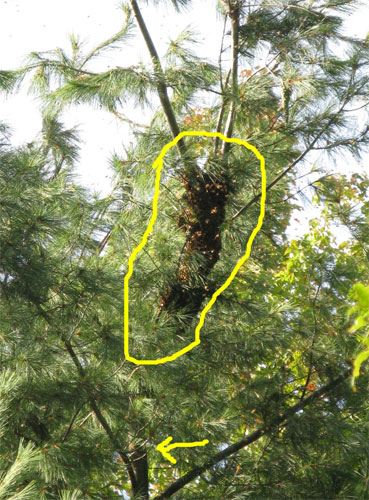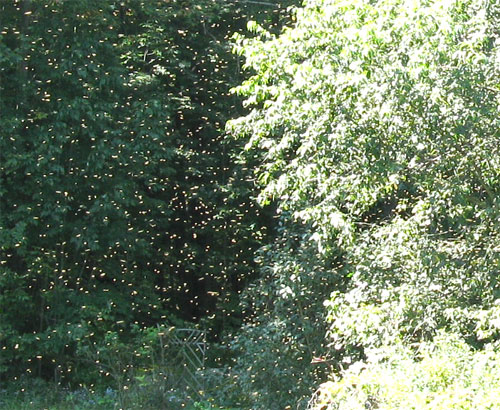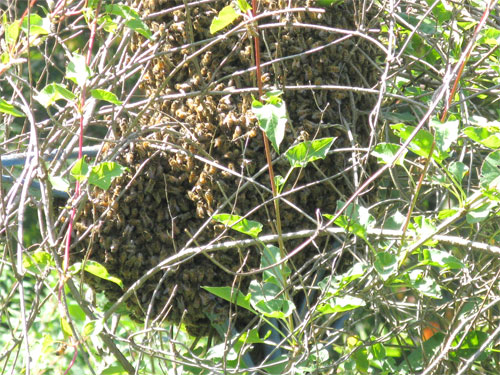The bee story starts a decade ago, so you don’t even want the Reader’s Digest Condensed version, but only the short-short version. And if this seems long, trust me, it’s short.
A swarm of bees splits off from the main hive when nature signals them to. For reasons only a little bee brain can determine, a swarm decided to move into my house. Ok, not INTO into the house, but into the outside wall. Bee experts were called, and ultimately bees were killed. That worked for the season. But apparently the original swarm made some honey in the wall, and that bit of honey attracts new swarms every year.
Bees are critical to us, their pollination of food crops essential. Honeybees have had a really hard time in the last few years, so purposely killing them is not a good idea. However, living in the sticks I have one basic rule about wildlife that’s served me well over the years: I won’t bother you outside, but you can’t live in my house. If you attempt to live in my house and I can’t reasonably remove you, you must die. It usually feels really crappy to kill things, even things as small as bees, but if I start sharing my house with uninvited guests, the ultimate consequences are pretty ugly. Think about rodents, bats, bugs, bees, spiders, ants, and all the other things that come inside. They can do real damage, not to mention making unsanitary conditions. But I digress.
I thought I’d escaped the bees this year, having seen very few scout bees. (Bees have apian real estate agents. Scout bees fly around and scope out prime living quarters, then go back & tell the rest of the gang, “Have I got a place for you!â€) Then suddenly, without warning, a swarm moved in while I was at work on Wednesday. I took my usual action: wait till there’s a bunch of bees hanging on the outside of the opening and spray them. Repeat as necessary. This was going as planned, when suddenly Thursday afternoon I sprayed and didn’t get the usual response – instead bees started POURING out of the house! I stood on my deck with my mouth hanging open for some minutes watching wave after wave of bees leave my house – I’d never seen such a thing. Although I’ve never been stung, or even harassed, by a honeybee, when there were thousands of them in the air I decided I’d better grab my little dog and go inside.
The swarm of bees moved to a pine tree on the edge of the driveway. It’s kind of hard to see how large this clump of bees is hanging on the tree branch, but look at the difference in size of the branches in the circled area (bees) and the surrounding non-beed sections. I’ve pointed to a big branch without bees, and even that is significantly smaller.

The bees spent the night in the tree. Fine with me. Friday morning, however, they were on the move – back up into my yard. Armed with newly-purchased cans of bee spray, I occasionally sprayed the advancing edge of the bees – I didn’t want them to move back into the house. The next photo gives you some idea of a bee swarm in the air – all those little white specks – bees.

This small swarm (unfortunately I’d apparently killed quite a few) finally settled on my arbor. That’s ok.

Call friends, who call friends, who call a guy who raises bees, who came to the house to collect this swarm. Unfortunately, about 5 minutes before he arrived the entire swarm lifted off and moved to places unknown. While the bee guy was here, he told me several bee facts.
I’m opting for the caulking option. It may not work completely in my first attempt, but it’ll be infinitely cheaper and less stressful to me. Sorry, bees.
As I sit on my porch writing this, the only sound I hear is bzzzzzzzzzzzzzzzzzzzzzzzzzzzzzzzzzzzzzzzzzzzzzzzzzzzzzzzzzzzzzzzzzzzzzzzzzzzzzzzzzzzzzzzzzzzzzzzz.


[…] I was hearing it over the moderate level of NPR bringing me the morning news. Uh, oh. That means bees are swarming again. Get up & go on the porch, yep, the air is filled with bees. Run to the kitchen & grab […]
Wow!!!!! Thank heavens they weren’t Africanized bees!!!
I too am sorry about the bees but your rule is sensible. I have no answers, of course, but I do know that after he retired Sherlock Holmes became a bee-keeper. You might want to contact him. I don’t have a phone number but his address in London is: 221B Baker Street. [ Note the “B!”}